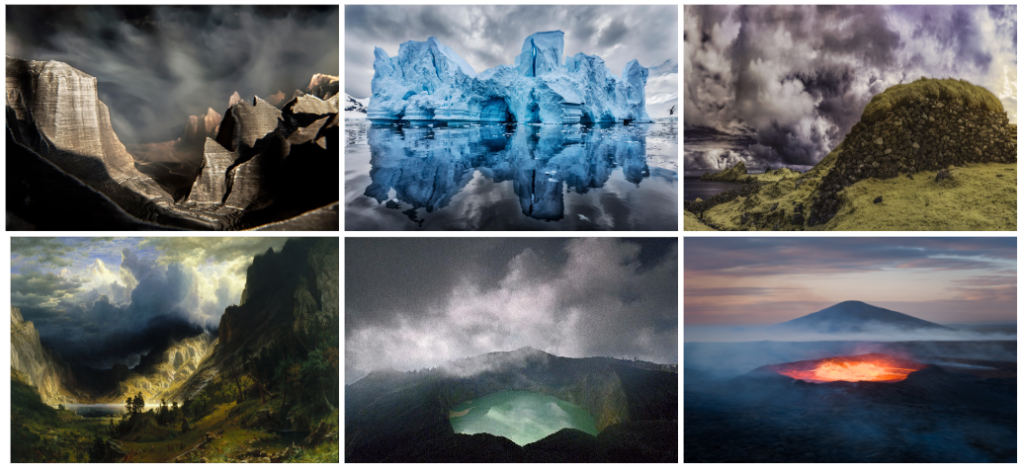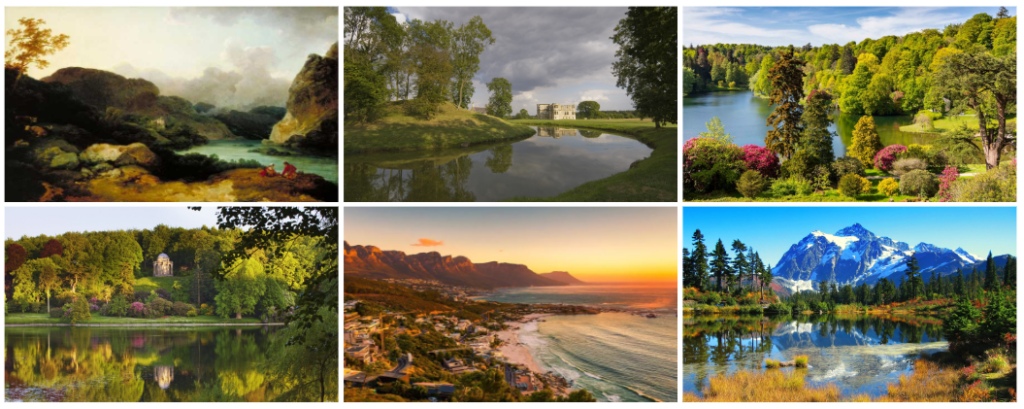Romanticism
The beautiful, the sublime, and the picturesque are three key concepts in aesthetics and philosophy of art.
Romanticism was an artistic, literary, musical and philosophical movement that originated in Europe toward the end of the 18th century. It gained momentum as an artistic movement in France and Britain in the early decades of the nineteenth century and flourished until mid-century. It was characterised by its emphasis on emotion and individualism as well as glorification of all the past and nature, preferring the medieval rather than the classical. It was partly a reaction to the Industrial Revolution. It incorporates a deep feeling of emotions such as apprehension, horror and terror, and awe. Romanticism was a huge step away from the subtleties of photography and instead looked very bold and striking. Romantic landscapes are typically “moody” in atmosphere; they are more about the subjective feelings of the artist, than an objective record of the observable world.

Romantic artists often sought to capture the moods, feelings, and emotions of their subjects, using expressive compositions, vivid colours, and dramatic contrasts of light and dark to do this. Photographers who also took up the romanticist approach aimed to sensationalise the overall look of their images by enhancing certain colours in order to make their images surreal, glorified and to dramatize certain areas of their photographs.
Romanticism first showed itself in landscape paintings, where British artists in the 1760s began to turn to wilder landscapes, storms, and gothic architecture.
The Sublime
The sublime is the quality of greatness, whether physical, moral, intellectual, metaphysical, aesthetic, spiritual, or artistic. The term especially refers to a greatness beyond all possibility of calculation, measurement, or imitation.
It is defined as a pleasure in the way that nature’s capacity to overwhelm our powers of perception and imagination is contained by and serves to vivify our powers of rational comprehension. It is a distinctive aesthetic experience. For Romantics, the sublime is a meeting of the subjective-internal (emotional) and the objective-external (natural world).

The sublime is closely associated with the Romantic movement, the concept of the sublime began to be employed by those who wished to challenge traditional systems of thought that were couched in the old language of religion, a rhetoric that now seemed founded on outdated conceptions of human experience.
Edmund Burke noted that there were certain experiences which supply a kind of thrill or shudder of perverse pleasure, mixing fear and delight. He shifted the emphasis in discussions of the sublime towards experiences provoked by aspects of nature which due to their vastness or obscurity could not be considered beautiful, and indeed were likely to fill us with a degree of horror.

At one extreme was the sublime (awesome sights such as great mountains) at the other the beautiful, the most peaceful, even pretty sights. In between came the picturesque, views seen as being artistic but containing elements of wildness or irregularity. One of the earliest theorists of the picturesque, Uvedale Price, situated the picturesque between the serenely beautiful and the awe-inspiring sublime. A picturesque view contains a variety of elements, curious details, and interesting textures, conveyed in a palette of dark to light that brings these details to life.
Romanticism inspired photoshoot:

For this photoshoot, I went to different places around Jersey and photographed various different natural landscapes eg La Corbiere Lighthouse. I took my images in both portrait and landscape in order to get a variety of outcomes and make my images more interesting to look at instead of them all being in the same rotation. I think I successfully managed to capture the beauty of these places in my photographs through the bright colours and detail in each image. I enhanced the colours on photoshop using levels and curves. One improvement I would make for next time, is I would try and photograph some landscapes in other whether conditions as most of my images are sunny. But, if I photographed some in other whether conditions like fog or when its cloudy, I could enhance this feature in order to get more of a romanticised image as the scary whether conditions would provide that theme of fear in romantic images, given to the person who looks at my images.


